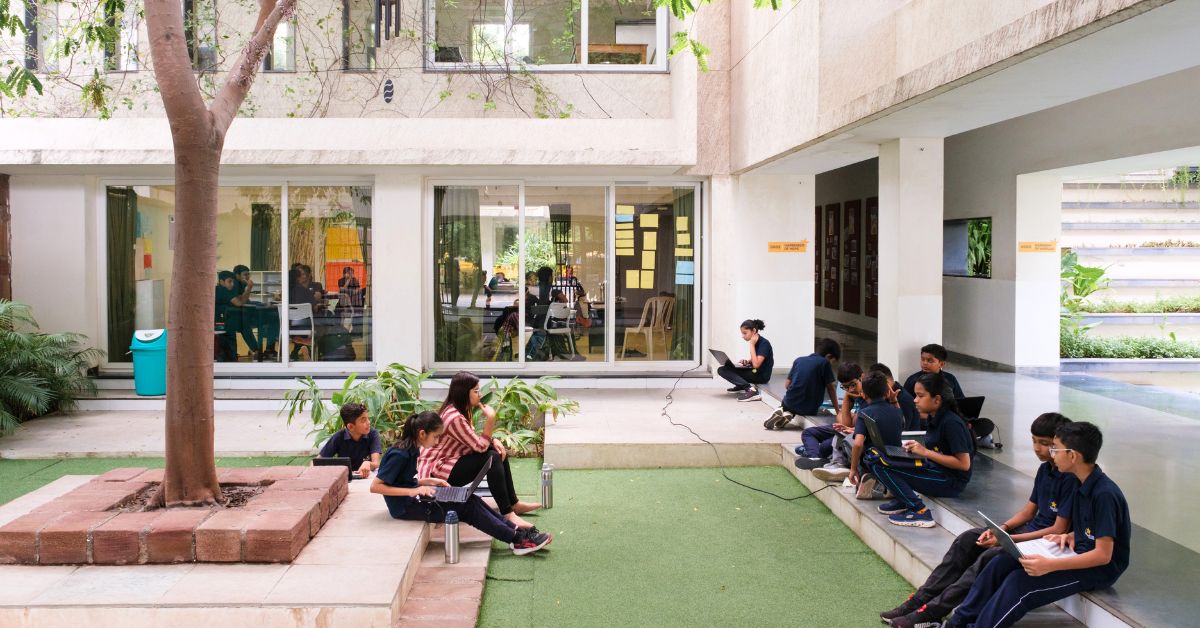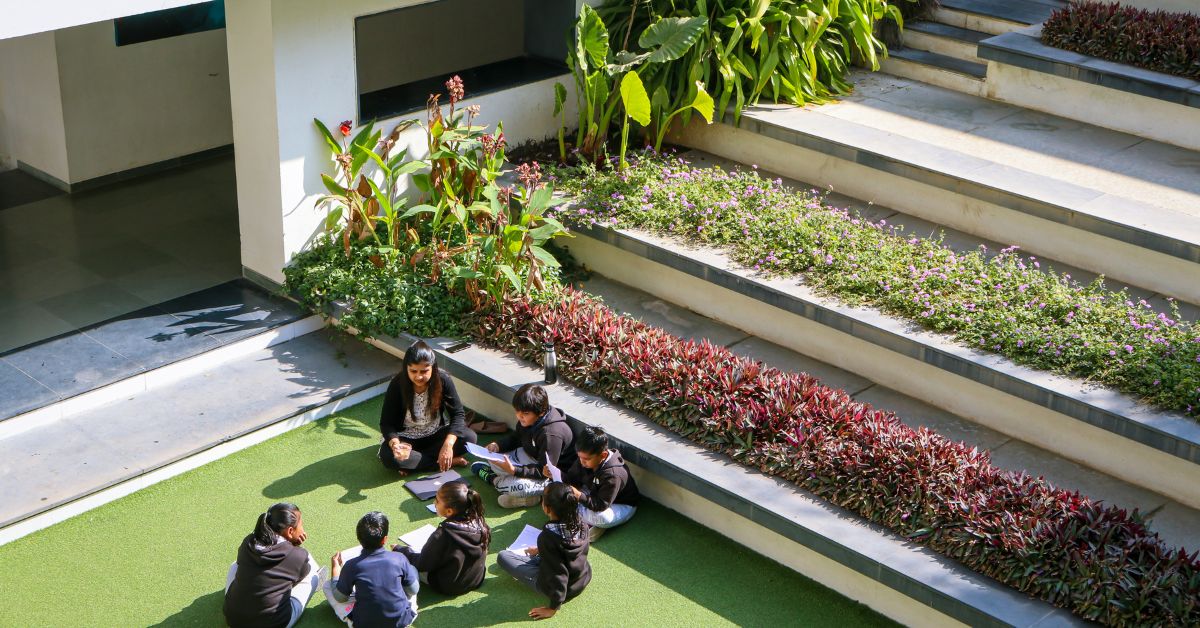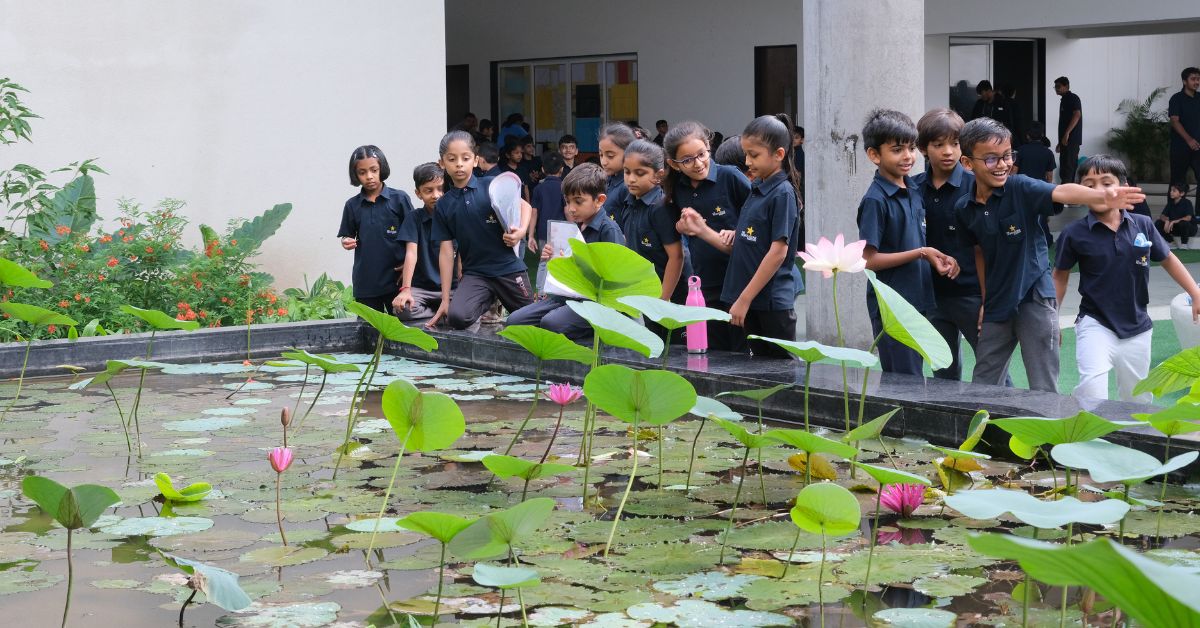Once a Harvard Project, This Sustainable School Teaches Kids Amid Nature
Blazing a trail in sustainability, Rajkot's Northstar School practices rainwater harvesting, uses little electricity and ensures that children spend more time outdoors.

What do you remember most about your school? Is it the classrooms or the open spaces, the amphitheatres where you had your annual days or the basketball courts/football fields/grounds where you spent hours playing with your friends? In a sense, what we learn outside sticks with us more than what we do in classrooms.
Rabindranath Tagore established the Santiniketan in 1901, an educational institution where students could learn in the lap of nature. In fact, teaching was done in the ancient Indian Gurukul system in the open under the trees.
The Northstar School in Rajkot is an attempt to go back to our roots, where learning is not confined within four walls. Inspired by the gurus in ancient India and wanting to replicate that kind of open learning where students are connected to nature in every space, Mohit Patel started this school in 2016. While studying at Harvard, the 38-year-old realised that the way schools are run today is in direct conflict with the way children learn.
Set across a sprawling 15-acre campus, the school has more outdoor spaces than indoor and lays great emphasis on climate and sustainability, featuring integrated water management systems, an energy efficient architecture allowing nature light and cooling, and use of natural and local materials.
Out of the 15 acres, the academic blocks only make up 2 acres. The remaining 13 acres are play areas, cricket fields, swimming pools, athletic tracks, fruit orchards and more.
Along with designing the curriculum, equal importance was given to the architecture, to ensure that Mohit’s vision was brought to life. It was done so with architects Shanmugam associates, who ensured that the school was airy, with a lot of open spaces and provided a comfortable environment for students.
Studying in the lap of nature

The idea for this school actually began as a class project in 2012, when Mohit was pursuing a Masters in Education at Harvard University. The project was on designing a school. Mohit looked at it from two perspectives, one being curriculum and the other, space design.
“What I thought of when I worked on the project was, how do we design learning experiences? Another important question I had was how do you fit these experiences into a space design? I conceived the project for a school in India and not America,” Mohit tells The Better India.
After returning to India, he started conceptualising and thinking about how he could convert what was on paper into reality. After working on the curriculum, Mohit joined hands with the team at Shanmugam associates who worked on the space and building design.
Mohit explains that he was clear that the school should look “nothing like a school we’ve been used to looking at”. He wanted kids to spend more time outside the classroom than inside the classroom.
With this pitch in mind, Santosh Shanmugam and Raja Krishnan D, principal architects at the architecture firm, started planning the school. They decided to go back to the roots and design a space where students can learn from nature.
“We started working with the view that when you enter this school, you should get a feeling that you’re connected to nature and open in every classroom and space. In a large space like this, we first started with a small portion, a classroom and then multiplied it across the campus. We designed each classroom with gardens on either side, to have good cross ventilation. Since Rajkot gets very hot, we incorporated small jali screens to cool the air or block the dust,” adds Santosh.
The architects have interspersed landscape in every space possible. You are welcomed by
Gulmohar trees at the entrance which create a canopy. There is a central courtyard which is inspired by the stepped wells of Gujarat which serves a space for classes, performances, and has greenery incorporated through creepers and vines. Each classroom has its own private garden and an open courtyard, where classes too can be conducted, a la Santiniketan.
By having gardens on each side, a microclimate is created in each classroom. This keeps the temperature lower than the outside environment. The windows in the classrooms directly open up to the garden.
The steps in the courtyard double up as a stage or place for rehearsals during events. The open corridors also come with ample seating for students to lounge and interact with teachers.
The architects have used local, indigenous materials like Kota stones and local limestones. Their mission was clear: Every space a child is in must be one with nature, be it a classroom, staff room, the toilets, courtyard or the play areas. They have green, vegetated screens on the first floor outside classrooms to give a garden feeling, and also reduce dust.
Every window or door opens out into a green space or garden. The school also has a horticulture program that teaches students the process of growing flora and fauna, and is aimed to foster a deep-rooted connection with earth and climate. The fruit orchards offer a hands-on experience for the students with the environment.
A sustainable model for waste management

The school also has a waste management system for water, food, and sewage. All the kitchen waste and food waste is reused as manure within the campus. All the water is also recycled and there is a Sewage Treatment Plant (STP) in the school. Rainwater is also harvested and used for recharging the borewells.
“The site topography slopes towards culvert and stream. So the rainwater is naturally directed towards the borewell for groundwater recharge which eventually goes to the Aji river. We’ve done this by keeping the topsoil of the campus loamy to provide for adequate rainwater drainage. We are also building a rainwater collection and percolation tank,” adds Mohit.
The architects add that they designed the campus in a way where usage of electricity is reduced. Raja explains that you don’t need much lighting during daytime and air conditioning is used only in summers. Their design ensures that the school is energy efficient.

“We always feel that architecture should take care of the climate by design and planning rather than by any mechanical equipment. That’s how the building ages well, feels well, feels comfortable. In a traditional school, you have corridors and classrooms on all sides. Our classes are designed in modules, so there’s no class which touches each other. A classroom gets light from both sides and is naturally lit. Our corridors never need to be lit up because there’s so much natural light and because it’s open,” says Raja.
Northstar has 500+ students and 80 teachers. Each class has a student strength of 20-25, maximising the area and amenities available for each student.
Mohit’s idea is for children to enjoy school. Everything else is secondary, he says. The school doesn’t have exams till Class 10, and students are not pressured into running the rat race of IITs, medical entrance coaching from Class 8 itself. A school, he says, should not be thought of as a means to gain admission to a reputed college, it should be an entire experience of its own.
“Students should be comfortable and happy in class. As long as kids are feeling happy being in school, everything else is going to follow. Learning is a byproduct of being curious, of being happy, being in good surroundings. That comes from the teachers, our relationship with our peers, the building, the environment; with everything. We want students to learn, become good human beings, imbibe critical thinking. Schooling in itself is an experience, not a means to do something else,” says Mohit.
The goal and vision of the school is to help students ‘explore their true north’. If you found our stories insightful, informative, or even just enjoyable, we invite you to consider making a voluntary payment to support the work we do at The Better India. Your contribution helps us continue producing quality content that educates, inspires, and drives positive change. Choose one of the payment options below for your contribution- By paying for the stories you value, you directly contribute to sustaining our efforts focused on making a difference in the world. Together, let’s ensure that impactful stories continue to be told and shared, enriching lives and communities alike. Thank you for your support. Here are some frequently asked questions you might find helpful to know why you are contributing?

Raja says that he used to hate going to school as he was burdened with homework and exams. “Now, I really want to go back to school and do my schooling at Northstar,” he laughs.
Edited by Padmashree Pande
This story made me
- 97
- 121
- 89
- 167














